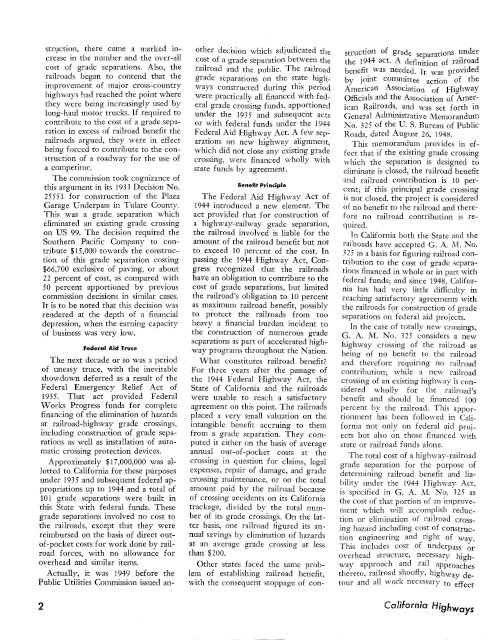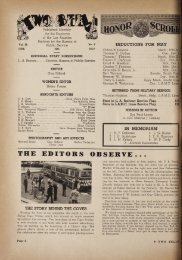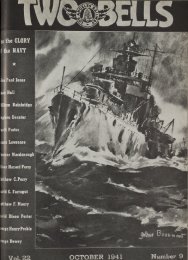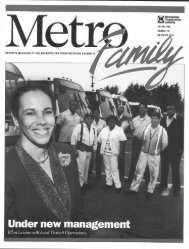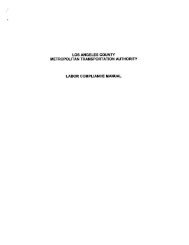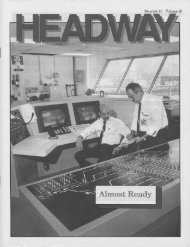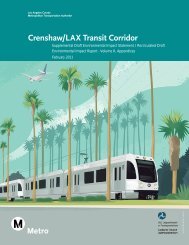1954 - Periodicals - CALIFORNIA HIGHWAYS AND PUBLIC ... - Metro
1954 - Periodicals - CALIFORNIA HIGHWAYS AND PUBLIC ... - Metro
1954 - Periodicals - CALIFORNIA HIGHWAYS AND PUBLIC ... - Metro
Create successful ePaper yourself
Turn your PDF publications into a flip-book with our unique Google optimized e-Paper software.
tion engineering and right of way,<br />
bility under the 1944 Highway Act,<br />
the cost of that portion of an improve-<br />
ment which will accomplish reduc-<br />
grade separation for the purpose of<br />
determining railroad benefit and lia-<br />
California Highways<br />
is specified in C. A. ~~~. i~TO. 325 as<br />
tion or elimination of railroad cross-<br />
railroads have accepted G. A. ~~~L No.<br />
This includes cost of underpass or<br />
ing hazard including cost of construc-<br />
In the case of totally ne~v crossings,<br />
tour and all «~orlc necessary to effect<br />
The total cost of ahighway-railroad<br />
thereto, railroad shoofly, high~,ay de-<br />
~vay approach and rail approaches<br />
overhead structure, necessary high-<br />
ects but also on those financed with<br />
fornia not only on federal aid proj-<br />
eliminate is closed, the railroad benefit<br />
crossing of an existing high«-a~~ is con-<br />
tionment has been followed in Cali-<br />
This memorandum provides in ef-<br />
highway crossing of the railroad as<br />
tribution to the cost of grade separa-<br />
325 as a basis for figuring railroad con-<br />
fore no railroad contribution is re-<br />
of no benefit to the railroad and there-<br />
and railroad contribution is 10 per-<br />
which the separation is designed to<br />
fect that if the existing grade crossing<br />
cent; if this principal grade crossing<br />
the railroads for construction of grade<br />
federal funds; and since 1948, Califor-<br />
In California both the State and the<br />
No. 325 of the U. S. Bureau of Public<br />
contribution; ~~hile a ne~v railroad<br />
and therefore requiring no railroad<br />
Officials and the Association of Amer-<br />
being of no benefit to the railroad<br />
reaching satisfactory agreements with<br />
tions financed in whole or in part with<br />
G. A. M. INTO. 325 considers a new<br />
nia has had very little difficulty in<br />
is not closed, the project is considered<br />
ican Railroads, and was set forth in<br />
General Administrative 1Vlemorandum<br />
by joint committee action of the<br />
struction of grade separations under<br />
benefit was needed. It was provided<br />
the 1944 act. A definition of railroad<br />
separations on federal aid projects.<br />
Roads, dated August 26, 1948.<br />
state or railroad funds alone.<br />
percent by the railroad. This appor-<br />
benefit and should be financed 100<br />
sidered wholly for the railroad's<br />
American Association of High~'ay<br />
quired.<br />
arations on new highway alignment,<br />
a highway-railway grade separation,<br />
way programs throughout the Nation.<br />
passing the 1944 Highway Act, Con-<br />
amount of the railroad benefit but not<br />
lem of establishing railroad benefit,<br />
The Federal Aid Highway Act of<br />
or with federal funds under the 1944<br />
from a grade separation. They com-<br />
the railroad's obligation to 10 percent<br />
crossinb in ,question for claims, legal<br />
For three years after the passage of<br />
Federal Aid Highway Act. A few sep-<br />
trackage, divided by the total num-<br />
crossing maintenance, or on the total<br />
separations as part of accelerated high-<br />
the railroad involved is liable for the<br />
act provided that for construction of<br />
under the 1935 and subsequent acts<br />
were practically all financed with fed-<br />
Other states faced the same prob-<br />
as maximum railroad benefit, possibly<br />
gress recognized that the railroads<br />
1944 introduced a new element. The<br />
State of California and the railroads<br />
grade separations on the state high-<br />
ter basis, one railroad figured its an-<br />
agreement on this point. The railroads<br />
heavy a financial burden incident to<br />
have an obligation to contribute to the<br />
to exceed 10 percent of the cost. In<br />
crossing, were financed wholly with<br />
ber of its grade crossings. On the lat-<br />
to protect the railroads from too<br />
which did not close any existing grade<br />
with .the consequent stoppage of con-<br />
at an average grade crossing at less<br />
nual savings by elimination of hazards<br />
placed a very small valuation on the<br />
annual out-of-pocket costs at the<br />
the 1944 Federal Highway Act, the<br />
the construction of numerous grade<br />
expenses, repair of damage, and grade<br />
amount paid by the railroad because<br />
puted it either on the basis of average<br />
cost of grade separations, but limited<br />
of crossing accidents on its California<br />
were unable to reach a satisfactory<br />
eral grade crossing funds, apportioned<br />
intangible benefit accruing to them<br />
ways constructed during this period<br />
railroad and the public. The railroad<br />
What constitutes railroad benefit?<br />
state funds by agreement.<br />
Benefit Principle<br />
cost of a grade separation between the<br />
other decision which adjudicated the<br />
than $200.<br />
this argument in its 193 3 Decision No.<br />
Garage Underpass in Tulare County.<br />
at railroad-highway grade crossings,<br />
commission decisions in similar cases.<br />
Southern Pacific Company to con-<br />
being forced to contribute to the con-<br />
1935. That act provided Federal<br />
contribute to the cost of a grade sepa-<br />
struction of a roadway for the use of<br />
highways had reached the point where<br />
improvement of major cross-country<br />
tribute $15,000 towards the construc-<br />
The commission took cognizance of<br />
cost of grade separations. Also, the<br />
crease in the number and the over-all<br />
$66,700 exclusive of paving, or about<br />
railroads argued, they were in effect<br />
including construction of grade sepa-<br />
It is to be noted that this decision was<br />
ration in excess of railroad benefit the<br />
financing of the eliminarion of hazards<br />
they were being increasingly used by<br />
railroads began to contend that the<br />
50 percent apportioned by previous<br />
Federal Emergency Relief Act of<br />
on US 99. The decision required the<br />
25551 for construction of the Plaza<br />
long-haul motor trucks. If required to<br />
under 1935 and subsequent federal ap-<br />
eliminated an existing grade crossing<br />
rations as well as installation of auto-<br />
Works Progress funds for complete<br />
of uneasy truce, with the inevitable<br />
depression, when the earning capacity<br />
rendered at the depth of a financial<br />
tion of this grade separation costing<br />
lotted to California for these purposes<br />
showdown deferred as a result of the<br />
This was a grade separation which<br />
22 percent of cost, as compared with<br />
Public Utilities Commission issued an-<br />
the railroads, except that they were<br />
Approximately $17,000,000 was al-<br />
reimbursed on the basis of direct out-<br />
grade separations involved no cost to<br />
101 grade separations were built in<br />
of-pocket costs for work done by rail-<br />
this State `vith federal funds. These<br />
propriations up to 1944 and a total of<br />
The next decade or so was a period<br />
Actually, it was 1949 befare the<br />
road forces, with no allowance for<br />
struction, there came a marked in-<br />
matic crossing protection devices.<br />
overhead and similar items.<br />
Federal Aid Truce<br />
of business was very low.<br />
a competitor.


